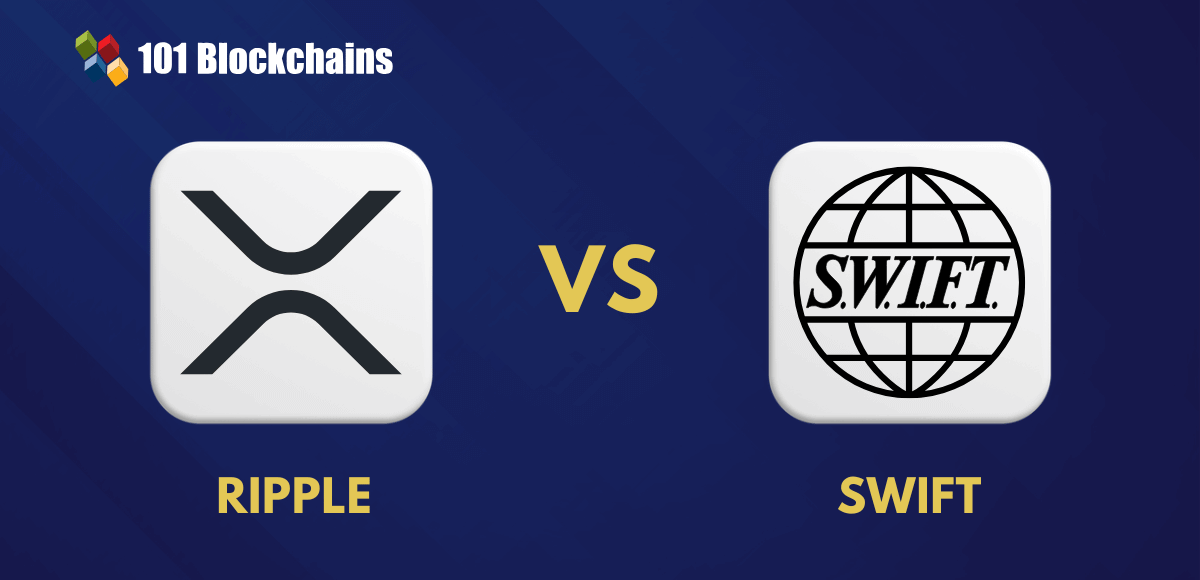Learn how blockchain truly works, master key definitions, and uncover what makes smart contracts so "smart." Dive into the fundamentals, gain valuable insights, and start your blockchain journey today!

- Comparisons
James Howell
- on November 18, 2022
Proof of Stake vs Delegated Proof of Stake
The major functions of blockchain technology rely on underlying value drivers for establishing lucrative value advantages. For example, the design of blockchain as a distributed ledger technology offers significant support for achieving decentralization. On the other hand, people following the cryptocurrency and blockchain community must have come across the Proof of Stake vs Delegated Proof of Stake debate.
Both of them are consensus algorithms and play a crucial role in facilitating transactions on blockchain networks. How can you determine the better option for creating a new blockchain-based protocol or application? The following discussion offers a detailed overview of the two consensus algorithms alongside the differences between them.
Become a certified blockchain expert with 101Blockchains’ Blockchain Certifications designed to propel your career in blockchain technology.
What are Consensus and Mining?
Consensus and mining are the two crucial elements of blockchain technology operations. As a matter of fact, the two terms can offer a promising explanation for the answers to “What is the difference between Delegated Proof of Stake and Proof of Stake?” with clarity regarding their importance. Blockchain works as a decentralized network wherein you can find multiple participants connected to the network. When a particular user wants to conduct a transaction, they must add it to the blockchain network.
Now, the user would need validation for adding their transaction to the blocks in a blockchain. At this point in time, consensus would come into play to ensure that all network participants agree to the validity of the transaction. A transaction can happen on a blockchain network only through the consensus among different network participants. Consensus ensures that all the members of the blockchain network are on the same page regarding a particular transaction.
Blockchain networks use different consensus algorithms through which blockchain network participants can agree on transactions. For example, Proof of Work, Proof of Stake, and Delegated Proof of Stake. Each type of consensus algorithm works with a different approach, generally as an improvement over conventional consensus algorithms.
The PoS vs DPoS comparison would also emphasize the role of mining. Have you ever wondered about the rationale behind other participants in a blockchain network working to validate your transactions? As a matter of fact, the process of verifying transactions is a competition, and users who can come up with proof of validity could earn rewards.
The resources you invest in a consensus algorithm for mining would help in differentiating Proof of Work and Proof of Stake consensus mechanisms. For example, Proof of Work requires an investment of high-end computing power, while Proof of Stake involves an investment of cryptocurrency stakes.
Different Types of Consensus Algorithms
Before you dive into the difference between DPoS and PoS consensus algorithms, you must understand the types of consensus mechanisms carefully. Consensus mechanisms are one of the core elements of blockchain technology and play a crucial role in blockchain security and the data on them.
According to the basic definition of consensus algorithms, they are a mandatory requirement before blockchain networks can process new transactions. Some of the notable types of consensus algorithms include Proof of Work, Proof of Stake, and Delegated Proof of Stake mechanisms. However, Proof of Work will always remain the first-ever consensus mechanism, especially considering the fact that Bitcoin uses PoW consensus.
The Original Consensus Mechanism
Prior to the definitions of PoS and DPoS consensus algorithms, you must understand the working of Proof of Work consensus. As a matter of fact, you can understand ‘what is proof of stake’ by identifying the fundamentals of Proof of Work. PoW consensus requires computing work from nodes all over the world involved with a decentralized blockchain network. Bitcoin employs the Proof of Work consensus, and users have to invest computer processing power to solve a computational puzzle.
The nodes which conduct the process are referred to as miners. Upon solving the cryptographic puzzle, miners could define the validity of their data block and add it to the blockchain. In return for their efforts, miners could receive Bitcoin as block rewards, and they could move on to the next transaction. Proof of Work consensus has been criticized for consuming considerably high levels of energy. On the other hand, it has also offered proven success in ensuring stability and security across different blockchain networks.
Curious to learn about blockchain implementation and strategies? Enroll Now in Blockchain Technology – Implementation And Strategy Course
What is Proof of Stake?
The first player in the Proof of Stake vs Delegated Proof of Stake debate, i.e., PoS, emerged as an alternative to Proof of Work. The primary objective behind the design of PoS consensus focused on ensuring energy efficiency. Interestingly, the PoS consensus would not rely on multiple nodes competing with each other and spending energy on the confirmation of network data.
On the contrary, the task of verifying transactions and data is entrusted to network nodes that stake or lock their assets in PoS consensus as collateral. The global blockchain developer community has tried and tested the concept of the PoS consensus algorithm. Interestingly, Proof of Stake has been hailed as the inevitable successor to Proof of Work in the constantly expanding decentralized technology landscape.
Ethereum is one of the foremost players in the crypto space working on the transition to Proof of Stake consensus. Apparently, the Ethereum 2.0 upgrade would introduce Proof of Stake as the default consensus mechanism. Many other blockchain networks using Proof of Stake include Tezos, Synthetix Network, Cosmos, EOS, Cardano, and Algorand.
You can determine answers to “What is the difference between Delegated Proof of Stake and Proof of Stake?” with an understanding of how PoS works. Proof of Stake does not encourage any form of energy-intensive mining. On the contrary, the Proof of Stake consensus chooses a validator randomly for validating data blocks. In the case of PoS consensus, any error could cost more than the reward for the block.
At the same time, it is also important to notice the methods used in Proof of Stake for the selection of validators. Proof of Stake consensus is unique in the fact that it could select validators randomly. Some of the factors used for the selection of validators include the size of the stake and the duration of staking. Individuals with a higher number of tokens staked on the platform would have higher chances of selection as validators. In addition, you are more likely to be selected as a validator if you have retained tokens for a longer duration.
Another vital aspect in explanations for ‘what is proof of stake’ would reflect on a random selection of validators. The random selection of validators in the Proof of Stake consensus mechanism depends on a combination of the lowest hash value and largest stake.
Learn more about the Ethereum Technology. Enroll now in Ethereum Technology Course.
Advantages and Drawbacks in Proof of Stake
The outline of differences in a PoS vs DPoS comparison would also emphasize the incentives and penalties with PoS consensus. Proof of Stake employs a unique mechanism for preventing any malicious acts or fraudulent transactions on the blockchain. Prospective validators have to stake more value in tokens than the transaction fees they could earn. In the case of any fraudulent activity, validators would lose their stake and receive a ban on participating in the validation process in the future. Such a system could help encourage trust among the respective individuals.
Another significant advantage of Proof of Stake consensus points to the lack of hardware energy consumption, as demanded in Proof of Work networks. In the case of PoS networks, you would encounter a limited need for computation. At the same time, Proof of Stake also ensures the removal of barriers to entry through the exclusion of high-end computing hardware. Users would have to prioritize token stakes in a network for validating transactions rather than investing in expensive hardware. As a result, Proof of Stake consensus could encourage more users to participate in the development of new blocks.
However, Proof of Stake does not come out as a clear winner in the difference between DPoS and PoS consensus mechanisms. Why? The biggest criticism of Proof of Stake consensus is that it has been tailored for users with substantial crypto assets. It would always select validators who have more tokens staked in the network. Therefore, new variants of PoS consensus have evolved for resolving the concerns of partiality toward wealthy users. The new variants, such as Delegated Proof of Stake, follow a different approach to the selection of validators.
Start your blockchain journey Now with the Blockchains Fundamentals Free Course
What is Delegated Proof of Stake?
The advantages and drawbacks of Proof of Stake consensus set the stage for a discussion about the Delegated Proof of Stake or DPoS consensus mechanism. The definition of Delegated Proof of Stake or DPoS can show you why it is an improvement over PoS consensus. Delegated Proof of Stake is one of the popular variants of Proof of Stake consensus and relies on the voting process for the selection of delegates, who would validate the next data block. The delegates selected in the DPoS consensus are also referred to as block producers or witnesses.
The explanation for “What is Delegated Proof of Stake” would also focus on its working mechanisms. Users could vote for delegates by staking their tokens in a staking pool and associating their stake with the desired delegate. It is important to note that voters don’t have to transfer tokens to another crypto wallet for staking.
On the contrary, you can use a staking service provider to add tokens to the staking pool. Only a specific number of delegates are selected for validation of each new block, alongside introducing randomness. Elected delegates would receive the concerned transaction fees, which are shared with voters who had backed the delegates. Voters with more stakes are more likely to receive a higher share of the block reward.
Want to become a Cryptocurrency expert? Enroll Now in Cryptocurrency Fundamentals Course
Advantages and Drawbacks of DPoS
The Proof of Stake vs Delegated Proof of Stake comparison would also draw elements from the advantages and setbacks of the DPoS consensus mechanism. From the looks of it, Delegated Proof of Stake serves as a more democratic approach for the selection of validators. The biggest advantage of DPoS consensus is the fair opportunity for participation to a diverse group of people.
Delegated Proof of Stake consensus determines eligibility for participating in the consensus process on the grounds of a credible staking reputation. In addition, it also allows the option for voting out block producers or delegates, thereby encouraging the best behavior from them. One of the most notable benefits of DPoS focuses on faster transaction finality, which also ensures better energy efficiency.
At the same time, you can also explore ‘what is Delegated Proof of Stake’ efficiently by pointing at the setbacks with DPoS consensus. For example, Delegate Cartels could make the blockchain more centralized and vulnerable to attacks. Delegated Proof of Stake also represents the classic case of the minority making decisions for the majority.
Differences between Proof of Stake and Delegated Proof of Stake
The PoS vs DPoS debate draws two important concerns to the battle, such as block creation and governance mechanisms. Here is an overview of the differences between PoS and DPoS based on their design and functionalities.

Please include attribution to 101blockchains.com with this graphic. <a href='https://101blockchains.com/blockchain-infographics/'> <img src='https://101blockchains.com/wp-content/uploads/2022/11/Proof-of-Stake-vs-Delegated-Proof-of-Stake-1.webp' alt='Proof of Stake vs Delegated Proof of Stake='0' /> </a>
-
Block Creation
Proof of Stake consensus relies on the selection of new block validators through a random approach. The PoS system would utilize the coins of users at stake as a metric for determining the selection of validators. On the contrary, the DPoS system uses a democratic process for the selection of block producers. With a limited number of block producers, Delegated Proof of Stake offers better scalability.
-
Governance
The governance of Proof of Stake blockchains depends completely on the encoding rules and parameters. Any changes in the rules for PoS blockchains would result in a fork for the protocol. In the case of DPoS, governance follows a democratic approach, wherein delegates take over active roles in the governance of the protocol. The delegates or block producers could propose new changes to the protocol, albeit with approval from users for their implementation.
Start learning Blockchain with World’s first Blockchain Skill Paths with quality resources tailored by industry experts Now!
Bottom Line
The detailed overview of the Proof of Stake vs Delegated Proof of Stake comparison showed distinctive highlights about the consensus mechanisms. One of the first things you could notice in the explanation for both consensus mechanisms is their uniqueness. Each consensus algorithm features its own merits and demerits. Ultimately, the choice of a consensus mechanism depends on the vision of the developers of a blockchain-based project. Learn more about blockchain and consensus algorithms in detail to make the right choice.
*Disclaimer: The article should not be taken as, and is not intended to provide any investment advice. Claims made in this article do not constitute investment advice and should not be taken as such. 101 Blockchains shall not be responsible for any loss sustained by any person who relies on this article. Do your own research!






